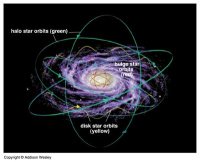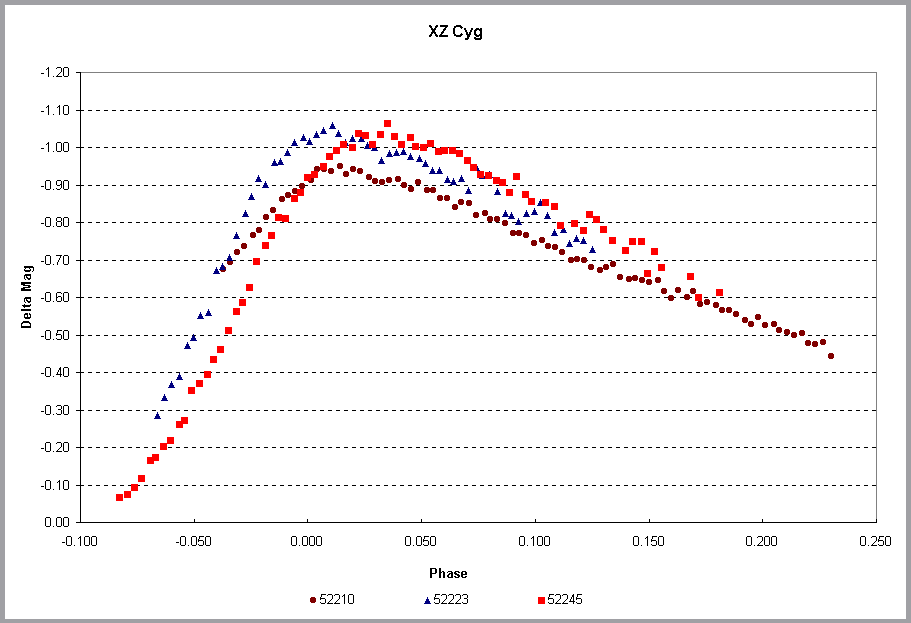The Impulsive XZ Cygni
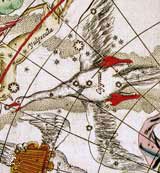 |
| The constellation Cygnus |
Born in Russia, Lydia Tseraski (Ceraski) (1875-1923+) graduated from the Teacher's Institute in Petersburg and married the Russian astronomer V.K. Tseraski. She worked at the Moscow Observatory where she is known to have discovered the variability of 219 stars, one of which is our feature star this month, XZ Cygni. Since its discovery on photographic plates in 1905, XZ Cygni has captured the attention of variable star observers and researchers around the globe because of its unusually large changes in period throughout the years. XZ Cygni is an RR Lyrae type star, that pulsates with a period of 11.2 hours. Its brightness ranges from 8.7 to 10.4 magnitude and it climbs from minimum to maximum in about one hour. Observing this rapid rise to maximum can be an exhilarating experience - especially if you are accustomed to waiting days, weeks, or even months for a maximum as is the case with the long period variables. Located in the constellation Cygnus, XZ Cygni is within reach of small telescopes and will be observable for the next couple of months from Northern latitudes. By investigating the whimsical ways of XZ Cygni and other RR Lyrae stars, it is possible to expand our knowledge of stellar evolution and pulsation theory, learn more about the early history of the Milky Way Galaxy and possibly refine the distance measurement to systems in which these RR Lyrae stars occur (although the exact intrinsic brightness of these stars is still a matter of considerable debate).
RR Lyrae Stars
Discovery and History
XZ Cygni is an RR Lyrae type variable star that was discovered in 1905- just around the time RR Lyrae stars were emerging as a new class of short period variable stars. In the following 100 or so years to the present, the number of RR Lyrae variables discovered has swelled to where they now outnumber known members of any other well-defined class of variable. The discovery of the RR Lyrae stars is closely connected with the realization that some of the stars in the globular star clusters are variable stars. In 1893, Solon I. Bailey initiated a program of globular cluster photography at the Harvard College Observatory station in Arequipa, Peru. In August of that year Williamina Fleming found on Arequipa Harvard plates a variable star in the globular cluster omega Centauri. A few days later Pickering found a second variable in the same cluster and at about the same time, Bailey himself found three variable stars in 47 Tucanae. The discovery of these first Arequipa variables stimulated further searches for variable stars within globular clusters. That started a flood of discoveries and between 1895 and 1898 Bailey searched photographs of 23 globular clusters for variables and he discovered more than 500. Variable stars were, however, not equally plentiful in every globular cluster. Some clusters had large numbers of variable stars while others had few if any variable stars (Smith 1995).
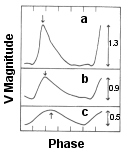 |
| Figure 1. The differing light curve shapes of RR Lyrae stars of Bailey type a, b, and c. Credit: RR Lyrae Stars, H.Smith, Figure 1.1, p.3 |
Bailey started to determine the periods and lightcurves for these globular cluster variables and it soon became apparent that these stars were of a particular type. They all had short periods of under one day and photographic amplitudes of about one magnitude. Moreover, the mean apparent magnitudes of the short-period variables within any given globular cluster were all about the same. The name 'cluster-type' variable was the term used to describe these variables that we now know as the RR Lyrae stars.
When S.I. Bailey published the results of his studies of the variable stars in the globular cluster Omega Centauri, he reported (1902) that three separate types of light curves seemed to be displayed by the stars that became known as Bailey types a, b, and c (Figure 1). Because these subclasses are still in use today we will quote Bailey's original description here (Although in modern astronomy, the seeming continuous subclasses a and b are grouped together and so it is simplified to just two types, ab and c, which are referred to as RRab and RRc types):
Subclass a ... Increase of light very rapid. Decrease rapid, but much less rapid than the increase. Light nearly constant at minimum for about one half of the full period, but perhaps during this time the light changes slowly. In this cluster [Omega Centauri] the range is generally a little more than a magnitude, and the period from twelve to fifteen hours.Subclass b ... Increase of light moderately rapid. Decrease is relatively slow and continues with lessening rapidity till about the beginning of increase, except that in some cases there is a tendency to a 'stillstand.' In this cluster [Omega Centauri], the range is generally a little less than a magnitude, and the period from fifteen to twenty hours ... This subclass is similar to a, of which it may be regarded as a modification.
Subclass c... Light appears to be always changing, and with moderate rapidity. Increase of light generally somewhat more rapid than the decrease, but in a few cases it appears to be of only equal, or of less rapidity. In this cluster [Omega Centauri] the range is generally somewhat more than half a magnitude, and the period from eight to ten hours...
Since Bailey's time, another subclass has emerged known as the "double mode" RR Lyraes or the RRd stars. These stars pulsate simultaneously in the fundamental and first overtone radial modes and will be discussed a little later in this article.
Although Bailey was discovering hundreds of RR Lyrae stars in globular clusters, at first only a few examples of this class were known outside of clusters, in the general field of the Galaxy. Williamina P. Fleming (1901) found a short-period variable in Lyra that seemed identical to the variables Bailey had found in the globular clusters. Slowly at first, and then with increasing frequency more of these field 'cluster-type' variables were found and since the term 'cluster variable' seemed inappropriate, Fleming's star, RR Lyrae, gave its name to the group.
A Separate Class?
By about 1915, there was sufficient data collected on the RR Lyrae stars to raise the question of whether they should be considered a separate class or included with their seemingly close relatives, the Cepheid variables. Though their periods were shorter, the lightcurve shapes of the RR Lyrae stars were similar to those of the Cepheid variables. Moreover, the basic mechanism of variability was assumed to be the same for both the Cepheids and the RR Lyraes based on similarities of their radial velocity measurements. Both Cepheids and RR Lyraes have a regular radial velocity variation with the same period as the light variation. By this time it was known that close binary stars showed a regular variation of radial velocity, and the obvious conclusion therefore was that the Cepheids (and subsequently the RR Lyrae stars) were binaries. It wasn't until 1914 that Shapley finally pointed out that the binary hypothesis had too many problems, the major one being that to produce the observed velocity curves the two stars would have to be inside each other! He encouraged the investigation of pulsation as the driving mechanism of light variation and in time he was proven correct (Smith 1995).
There are several features that markedly separate the RR Lyrae stars from the Cepheid variables. Their short periods and their abundance in some globular clusters are, of course, marks of distinction. Another difference, pointed out by Hertzsprung, is that most Cepheids are concentrated in the plane of the Galaxy whereas the RR Lyraes are found at all galactic latitudes. This developed into the understanding that while classical Cepheids belong to Population I, the RR Lyraes include halo stars of Population II. Thus, despite similarities with pulsating Cepheid variables of period longer than a day, the RR Lyraes were recognized as their own class of variable. More recently, the realization that all RR Lyrae stars are low-mass horizontal branch stars in the core helium burning stage of evolution has provided an additional argument for distinguishing them from the higher mass classical Cepheids (Smith 1995).
Current RR Lyrae numbers
Since Bailey's discovery of the RR Lyrae stars, they have become known as a common class of variable star. More than 90 percent of known globular cluster variables are RR Lyrae stars. RR Lyrae stars are also well represented among the field variables of the Galaxy. These field RR Lyraes are found in the halo of the Galaxy, in the thick disk, and in the galactic bulge. Reasonably good lightcurves and periods are available for about 4280 field RR Lyrae stars, and of these, about 91 percent are of type RRab and only 9 percent of type RRc. This may not reflect the actual ratio, however, because the RRc variables are more difficult to detect due to their smaller amplitudes (Smith 1995).
Use as Standard Candles
Since the time that Bailey started working on RR Lyrae stars, it has been known that, in any given globular cluster, these stars show a small range in mean brightness. This raised the possibility that all RR Lyrae stars have the same absolute magnitude and could therefore be used as standard candles to measure the distances to the systems in which they are located. In fact, the similarities between RR Lyraes and Cepheids encouraged Shapley to incorporate RR Lyrae stars in his calibration of the Cepheid period-luminosity relation. As tools for measuring distances to globular clusters, the RR Lyrae stars played a vital role in Shapley's determination of the distance to the center of the galaxy (Smith 1995). Of course, it is imperative that the absolute magnitude of these stars be determined in some way before they may be used as a standard candle and the results of this determination still seem to be somewhat inconclusive. RR Lyrae stars are not close enough to Earth to have their distances and thus absolute magnitudes measured directly by trigonometric parallax (although this may change in the future). Hence, the techniques used to measure RR Lyrae absolute magnitudes have been more indirect. Three basic approaches have been tried: statistical parallaxes, Baade-Wesselink solutions, and the determination by various independently calibrated methods (Cepheid period-luminosity relations, main sequence fitting, etc.) of the distances to systems that contain RR Lyraes. However, all RR Lyrae stars may not share exactly the same absolute magnitude and there has been much recent discussion as to whether RR Lyrae absolute magnitudes are a function of metallicity (Smith 1995).
Stellar Pulsation
The radial oscillations of a pulsating star are the result of waves (like sound waves) resonating in the star's interior. The sound waves involved in radial modes of stellar pulsation are essentially standing waves, similar to the standing waves that occur in an organ pipe that is open at one end. Both the star and the organ pipe can sustain several modes of oscillation. The standing wave for each mode has a node at one end (the star's center, the pipe's closed end) where the gases do not move, and an antinode at the other end (the star's surface, the pipe's open end). For the fundamental mode, the gases move in the same direction at every point in the star or pipe. Most RRab stars pulsate in the fundamental mode. In the first overtone mode, the gases are moving in opposite directions on either side of the node. Most RRc stars pulsate in the first overtone mode. The second overtone mode is similar with gases moving in opposite directions on either side of two nodes. It has sometimes been suggested that some RR Lyrae stars might pulsate in the second overtone but this possibility has also been refuted. A number of RR Lyrae stars have been found that show mixed mode behavior, pulsating simultaneously in the first overtone and fundamental modes. These double mode RR Lyraes are often called RRd stars (Ostlie and Carroll 1996).
To explain the mechanism that powers these standing sound waves, Eddington proposed that pulsating stars are like thermodynamic heat engines. The net work done by each layer of the star during one cycle is the difference between the heat flowing into the gas and the heat leaving the gas. For driving this process, the heat must enter the layer during the high-temperature part of the cycle and leave during the low-temperature part. Just as the spark plug of a car engine fires at the end of the compression stroke, the driving layers of a pulsating star must absorb heat around the time of their maximum compression. In this case the maximum pressure will occur after maximum compression, and the oscillations will be amplified.
Eddington first looked to the core of the star, where energy generation is taking place, for this driving process. We now know, however, that the core of a star is very dense and that stellar pulsation can only take place in the outer envelope of the star, which contains a small percentage of the total mass of the star. The pulsations of the variable have no direct effect upon the conditions in the core of the star. So it is in the envelope where this pulsation process must be sought.
Eddington then suggested an alternative that he called, a valve mechanism. If a layer of the star became more opaque upon compression, it could "dam up" the energy flowing toward the surface and push the surface layers upward. Then, as this expanding layer became more transparent, the trapped heat could escape and the layer would fall back down to begin the cycle anew. In Eddington's own words, "To apply this method we must make the star more heat-tight when compressed than when expanded; in other words, the opacity must increase with compression" (Ostlie and Carroll 1996).
In most regions of the star, however, opacity decreases with compression. It was the Russian astronomer S. A. Zhevakin verified by a German and two Americans, Rudolph Kippenhahn, Norman Baker, and John Cox, who realized the special conditions responsible for driving stellar pulsation. They found that the regions of a star where Eddington's valve mechanism can successfully operate are its partial ionization zones. In these layers of the star where the gases are partially ionized, part of the work done on the gases as they are compressed produces further ionization rather than raising the temperature of the gas. With a smaller rise in temperature, the increase in density with compression produces a corresponding increase in the opacity. Similarly, during expansion, the temperature does not decrease as much as expected since the ions now recombine with electrons and release energy. The opacity decreases with decreasing density during the expansion. This layer of the star can thus absorb heat during compression, be pushed outward to release the heat during expansion, and fall back down again to begin another cycle. Partial ionization zones are the pistons that drive the oscillations of stars; they modulate the flow of energy through layers of the star and are the direct cause of stellar pulsation (Ostlie and Carroll 1996).
The Blazhko Effect
 |
| Sergei Nikolaevich Blazhko (1870 - 1956) |
Most of the RR Lyrae stars repeat their lightcurves from cycle to cycle with amazing regularity. It was discovered early in this century by Blazhko (1907), however, that there were periodic variations in the primary light curve shape of some RR Lyrae stars. These variations may appear as changes in the slope of rise to maximum, changes in the height of maximum, or other changes of the shape of the light curve. For some of these stars, the lightcurve changes appear to be irregular, but in many instances the lightcurve variability can be attributed to the presence of a second periodicity. RR Lyrae variables which exhibit secondary periodicities can be divided into two main groups: the so-called RRd stars which show a mixture of fundamental and first overtone radial pulsation modes and the stars which show the classical Blazhko Effect.
The Blazhko effect manifests as a periodic modulation of the primary lightcurve shape on a timescale typically around tens of days. It seems to occur exclusively in RRab stars, although this might be an effect of selection bias. There doesn't seem to be a correlation between the length of the primary period and the length of the Blazhko period. A pronounced characteristic of the Blazhko effect is its irregularity. In at least some instances the behavior of the star does not repeat precisely at all Blazhko cycles. In some stars, as with RR Lyrae itself, the Blazhko effect nearly vanishes some years, but is very strong in others.
Though a number of hypotheses have been advanced, there is no accepted explanation for the Blazhko cycles. Stellingwerf (1976) in a review of multi-periodic RR Lyrae stars, listed six mechanisms which might create the Blazhko effect. Most speculation has centered on two possibilities. These are (1) that the Blazhko effect is the consequence of some type of mixing of pulsational modes and (2) that the effect is related to magnetic cycles in the stars, possibly coupled with rotation. Evidence can be brought to support either hypothesis, but both have weaknesses and neither are yet widely accepted (Smith 1995).
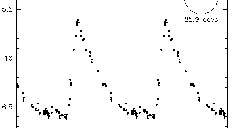 |
| Click on the above image to see an animation of the lightcurve data for a RR Lyr variable which displays the "Blazhko effect" Credit: D.L. Welch et al, the MACHO project. |
RR Lyrae Stars and Stellar Evolution
RR Lyrae stars are thought to be radially pulsating evolved low-mass (about 0.8 solar masses) stars in the core helium burning stage of their evolution. This places them on the horizontal branch in the Hertzsprung Russell (HR) diagram. But not all horizontal branch stars are RR Lyraes - there is a well-defined region of instability where stars are pulsationally unstable and are considered RR Lyraes. The exact evolutionary course of these stars depends upon mass and chemical composition among other things but their stories are similar. Like other low-mass stars, the progenitor of the RR Lyrae star spends most of its time burning hydrogen on the main sequence. After a significant amount of time (maybe 15 Billion years), it ascends the red giant branch, where it burns hydrogen to helium in a shell around the helium core. Temperatures in the helium core are not yet high enough to fuse helium atoms to form heavier elements and the inert core collapses and becomes electron degenerate. At the tip of the red giant branch the core temperature becomes hot enough to ignite helium and a helium flash occurs as the star initiates its core helium-burning phase of evolution on the zero-age horizontal branch. It is in this stage that, if the star falls within the bounds of the instability strip in the HR diagram, it pulsates as an RR Lyrae star. The RR Lyrae is a giant star at this point, with a radius 4-6 times that of the Sun, though both its radius and luminosity are much reduced from what they were at the tip of the red giant branch (Smith 1995).
Eventually, the helium source in the core will run out and the star will leave the horizontal branch. It swells and cools once again, ascending the asymptotic red giant branch while deriving fuel from hydrogen and helium burning in the shells around the core. Probably after expelling its outer gaseous envelope as a planetary nebula, the star continues to shine weakly as a white dwarf. Gradually the white dwarf will radiate away its internal heat energy at a low rate (Smith 1995).
Real-Time Stellar Evolution?
A recent Sky and Telescope (1998) article reports that according to Christine M. Clement (University of Toronto) the RR Lyrae star, V79, has exhibited behavior that might be an indication of real-time stellar evolution. Astrophysicists have been studying the behavior of stars and modeling how they react as they consume their nuclear fuel. Recent models predict that RR Lyrae stars in the globular cluster M3 will switch from deep, slow fundamental-mode pulsations to shallow but more rapid overtone pulsations as they become smaller and hotter overall. So when Clement and her colleagues found that V79 had recently switched from an 11.6-hour cycle to one only 8.6 hours long, they surmised that they had found a sign of evolutionary change. The switch took place sometime in the 1960s (when Russian and Hungarian astronomers took frequent photographs of M3) and 1996, when a sequence of electronic CCD images was acquired in an unrelated search for eclipsing binary stars. It is still uncertain, however, that this is exactly what is occurring with this star. And Clement's team points out in the November 1, 1997, Astrophysical Journal Letters, that V79 is actually now vibrating in both pulsational modes, though the relative amount of energy in the overtone mode is notably stronger. As RR Lyrae expert Horace A. Smith (Michigan State University) states, "It's very rare that you get to see real change in a star," and then "If this is evolutionary, it's very important. [But] it's not certain that this is what's happening."
A Closer Look at XZ Cygni
XZ Cyg, our variable star of the month, was discovered in 1905 and subsequently found to be an RR Lyrae "ab" variable with period about 0.467 d (about 11.2 hours) and a visual amplitude around 1.4 mag. S. N. Blazhko (1922) discovered that the light curve of XZ Cyg did not precisely repeat from cycle to cycle. Instead, the magnitude attained at maximum varied by 0.3 to 0.4 mag. for different cycles. Blazhko explained these fluctuations in terms of a secondary periodicity of length 57.4 d and a tertiary periodicity of lesser amplitude and period length half that of the primary. The secondary periodicity has since been confirmed and is called the Blazhko period while contradictory results were obtained for any additional periods.
| O-C Diagrams One very useful tool for finding period changes is to compute what is called "O-C" ("O minus C") diagrams. It is based on the following idea: if a star is perfectly periodic, then every period is exactly the same. In that case, we can predict its cycles in advance. If one maximum occurs on, say JD 2450000, and the period is precisely 332 days (and never changes!), then the next maximum will occur on JD 2450332. Then we can compare our predictions with future observations. By observing the star, we can calculate the observed time of maximum and compare it with our predicted time of maximum by simply taking the difference between the observed and computed times of maxima. These are the "O-C" or "observed minus computed" values. After you have determined the O-C values, you can plot O-C as a function of cycle number. When the O-C values lie on a straight line which is horizontal, the system is periodic and agrees with the calculated value of the period. If the O-C values lie on a straight line that is not horizontal, the system is periodic but the estimated period is not correct and the slope of this line is the difference between the true and estimated periods. When the O-C values change from one straight line to another which has a different slope, the period has changed and the slope of each line is the difference between its period and the estimated period. Finally, when the O-C values do not follow a straight line, the system is not perfectly periodic. Credit: Hands-On Astrophysics, Chapter 13 |
 |
| Click Image to enlarge. Figure 1 from Marv Baldwin's 1973 paper, this O-C diagram shows how the period of XZ Cygni has changed. |
XZ Cyg has created quite a stir among the observing community because of its unusually large and progressive change in period. Throughout the years of observation, XZ Cyg has exhibited some variations in its lightcurve, both in form and in brightness reached at maximum. Studies have found that the Blazhko period of XZ Cyg increased from about 57.4 to 58.3 days near JD 2438500 (April 1964) while at around the same time, there was a decrease in the primary pulsation period (from about 0.46658 d to 0.46645 d) of the star (Baldwin, 1973; Smith, 1975; Kunchev, 1975; Pop, 1975). In recent years, A. LaCluyze et. al. have determined that the primary period of XZ Cyg has increased to 0.4666 d, close to the value it had before its decrease. And their preliminary analysis of recent observations shows that the Blazhko period of XZ Cyg decreased to near 57 d coincidentally with the increase in primary period. These constantly changing periods make observing XZ Cygni a challenging and very exciting experience.
Observing XZ Cygni
 |
| Cygnus the Swan |
XZ Cygni is close enough to be observed with a small telescope at this time of year from Northern latitudes and is also encouraged as a target for PEP and CCD observers. As far as variable star observing goes, the action is pretty fast with a rise to maximum that takes as little as one hour, followed by a slower period of fading. Observers should start recording their observations about an hour and a half before the predicted maximum, while the star is still at minimum light. Visual observers should try to record an observation about every ten minutes, continuing for about one hour past maximum to ensure that a good maximum is well defined. CCD and PEP observers should try to get all of the accurate data you can get, as the AAVSO RR Lyrae committee chairmen Marv Baldwin says, "An accurate CCD data point per minute is not too frequent for a star that moves as fast as this one." Time your observations to the nearest minute. "Since the [brightness] changes are not great," warns Marv, "these stars are very unforgiving of sloppy observational work. The observer must be accurate and consistent." Take care not to let estimates made a few minutes ago influence your opinion of what the star looks like now.
The AAVSO has a Short Period Pulsators observing section, chaired by Gerry Samolyk, which can help you in your XZ Cygni observing runs. Since it is a program star, there are both Standard and Reversed charts available for download from the AAVSO website that will help you make estimates of this interesting variable. Currently, Marv Baldwin and Gerry Samolyk are preparing a monograph on this star, which includes hundreds of maxima timings and should be published in time for the AAVSO Spring Meeting 2003. You may also find the predicted times of maximum for XZ Cyg available in the RR Lyrae Star Ephemeris on the website as well. But be careful, the times listed may be off due to the star's whimsical ways - which makes XZ Cyg all the more interesting to follow!
For More Information
- "A Case of Real-Time Stellar Evolution?" Sky and Telescope, February, 1998, 22.
- Bailey, S. I. Harvard College Observatory Annual Report, 38, 1902, 132 and 208.
- Baldwin, Marvin E. "The 1972 Anomaly of XZ Cygni" The Journal of the American Association of Variable Star Observers, 2, 1973, 14-19.
- Baldwin, Marvin E. "A Short Period Variable With Changing Period" Variable Star Notes Royal Astronomical Society of Canada Journal, 65 no.6, 1971, 307-310.
- Blazhko, S.N. Astronomische Nachrichten, 175, 1907, 325.
- Blazhko, S. N. Astronomische Nachrichten, 216, 1922, 103.
- Fleming, W. P. Astronomische Nachrichten, 154, 1901, 425.
- Hazen, Martha L. "RR Lyrae Stars" The Journal of the American Association of Variable Star Observers, 15, 1986, 201-205.
- Kunchev P. Information Bulletin on Variable Stars, 1001, 1975, 1.
- LaCluyze A., Smith H.A., Gill E.-M., et al. "The Changing Blazhko Effect of XZ Cygni" Radial and Nonradial Pulsations as Probes of Stellar Physics, ASP Conference Series, 259, 2002, 416-417.
- MacRobert, A. "An RR Lyrae Observing Program" Sky and Telescope, June, 1985, 538-540.
- Martin C. and Plummer, H.C. "On the short period variable XZ Cygni" Monthly Notices of the Royal Astronomical Society, 74, 1914, 225 - 233.
- Ostlie, D. and Carroll B. An Introduction to Modern Stellar Astrophysics, Weber State University, Addison-Wesley Publishing Co., Inc. Reading, MA, 1996.
- Pop V. Information Bulletin on Variable Stars, 990, 1975, 1.
- Smith, Horace A. RR Lyrae Stars, New York, NY, Cambridge University Press, 1995.
- Smith, Horace A. "The Blazhko effect in observations of XZ Cygni" Publications of the Astronomical Society of the Pacific, 87, 1975, 465-470.
- Zaharov, G. Variable Star Bulletin, 9, 1953, 27.
This month's Variable Star of the Month was prepared by Kate Davis, AAVSO Technical Assistant, Web.



